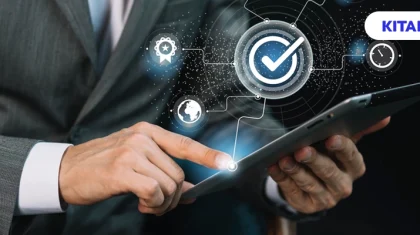
How to Make Interactive Training Program for Retail Employees
What’s training without interaction? Just a bunch of people staring ahead while their mind dwells somewhere else.
The only way to bring them back to the present and prevent them from getting lost in their train of thoughts again is to maintain constant interaction. Ask questions, give quick exercises, assign team-based activities. This stands true for school students as well as working professionals.
One might think that providing online training instead of instructor-led training would prove more effective. Well, that’s a myth. Merely providing training decks on computers or laptops or even the phone for that matter won’t be very effective unless it’s interactive. After all, they are the same lengthy rows of text and static images. Your employees are not going to like sitting at their workstations and reading plain texts, neither on paper nor on a computer.
And what about training program for retail employees? The ones who are not fixated to a desk. These are the employees who are mostly attending customers in a store. You can’t really expect them to go through training materials that resemble a novella. Retail employees are constantly needed on the floor, and therefore they require training content that can be accessed and read anywhere and anytime while on the move.
And that is why one needs interactive training programs. In this blog we will focus on ways to make interactive training programs for retail employees.
But first let us see how an online interactive training module benefits employees.
- It keeps the learners engaged
- Keep them focused on the course module
- Helps them memorize the content better
- Track and understand progress through instant reports
- Motivates them to pursue and complete the training program
How L&D teams Design an Engaging and Interactive Training Session for Retail Employees
1. Create video-based content
A staggering number of videos are being consumed every day by people all over the world, thanks to the increased smartphone usage. On average, there are 1,000,000,000 mobile video views per day, and the average mobile viewing session lasts more than 40 minutes. This shows that people never get bored of watching videos.
Your retail employees also undoubtedly form a part of this video-consuming generation. Delivering retail training in the form of videos, therefore, will be effective in engaging learners and helping them remember useful information. Video-based content must be supported by effective narration to increase knowledge retention. You can either go for an off-the-shelf video-based training material or even create one yourself in a cost-effective manner.
2. Create Audio files
You would find the majority of youngsters using earphones or headphones while doing mundane tasks. Tap into this habit by providing them with good quality audio files of the training materials.
This way, when the employee is busy stacking products or arranging shelves or travelling perhaps, they can listen to the audio-based learning materials and keep themselves up to date and complete their training programs. But audio should not be considered as the only form learning resource. It should be a supplementary resource that employees can use as per their convenience.
Moreover, some people are good at retaining stuff that they hear rather than by reading it. So, by creating an audio version of your training program, you cater to both types of learners- visual and auditory.
3. Use Augmented reality
Augmented reality is when you point your mobile phone camera towards a certain image or object and an enhanced digital version of the same is projected on the screen. In retail training programs, you can use augmented reality by allowing employees to point their devices at products, which would then display product details and specifications. Here’s more on can organizations get better ROI by using AR in training
This interactive and immersive mode of learning helps in keeping them engaged and learn facts in a fun manner. This technique can also be used by retail employees to showcase the features of the product to the customer, assisting them in their buying journey. Here’s How to Deliver Retail Sales Training to Remote Employees
Whitepaper:
Accelerate Employee Engagement with Mobile-based Corporate Training Program
4. Provide Branching Scenarios
Branching scenario is a training style where the learner selects the course of action which determines the end result. The employees are provided with a virtual scenario, along with options to determine what they would do in such a situation. Based on the options chosen by the employee, the learning journey unfolds at each stage with further choices. Each choice leads to a different path, and to one of the many possible conclusions.
This goes on until the employee achieves the desired result. Branching scenarios are a good way to build the employee’s decision-making skills. It helps them identify what to do in a particular scenario in real-world and prepares them to handle various situations which they might come across while on the job.
5. Interactive Assessments
Interaction occurs when every party involved in the training responds in some way or the other. In this case, the interaction is between a learner and most probably a smartphone. When the course throws out questions and features that require the employee to take action, it becomes an interactive experience for the employee. So, every time an employee clicks a button, plays an audio etc., there’s interaction happening right there.
Include quizzes to test the employees’ understanding of various concepts. These assessments can be in the form of multiple-choice questions, drag and drop, labelling, and so on. This provides a chance for the employees to understand their progress rate as well as gauge their understanding.
6. Gamify the content
Gamifications have become common practice in employee training. It includes using gaming principles such as levels and reward points to motivate the learners. Gamification acts as a catalyst that pushes the employee to score more points in the next level of the learning program.
And how do they do that? By completing each module within a stipulated time, solving a problem in a limited time, or by scoring high points in the online assessments. Features like points and timers gamify the scenario and appeal to the audience.
Conclusion:
Creating training programs for retail employees is a tricky task. Because you have to make it crisp and easily understandable, highlight important points, make them short so that it doesn’t take up a lot of time and also ensure that the employees can enjoy the learning experience. Adding a bit of fun element like gamification sure makes it more interesting. Here are 5 Ways to Create Effective Interactive Training Content
Constant interaction is what will keep them engaged in the learning material. If they were to just turn pages and go on reading texts, the training would have been less than effective. Hence, in order to train your employees, you must create an interactive training program for retail employees that can be easily accessed and completed while on the job.
Related:
- 10 Ways to Make Performance Oriented Retail Training
- How to Train Your Customer Facing Employees For Maximum Sales
- How to Create Interactive Content for Sales Enablement
- How to Improve the Sales Process with Mobile Content Delivery
- Will eBooks Replace Physical Textbooks in Higher Education
- How to Share Your Digital Content Securely with a Limited Audience
- Benefits of Digital Textbooks in Schools
Discover how a mobile-first training platform can help your organization.
Kitaboo is a cloud-based platform to create, deliver & track mobile-first interactive training content.





